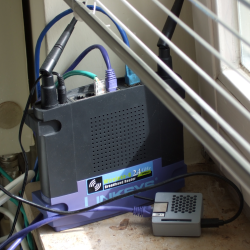It all started with an article about Wink Labs putting a monthly fee on their previously free service. It wasn’t so much the amount they were asking ($5 / month) that raised my hackles, but rather the fact that they would essentially render a device that you ostensibly bought worthless unless you paid up. I’ve ranted about this enough recently, and the quick summary is that IoT companies seem very bad at estimating their true costs, and the consumer ends up suffering for it.
So I started thinking about the price myself. Is $5 per month for a home automation service a lot or a little? On one hand, if you stretch that out to, say, 10 years, you end up with a net present value of something north of $400, plus $70 for the device. That’s a lot, right? Surely, I could DIY myself a solution for less? Or am I falling into the same IoT trap?
 This isn’t hypothetical, because I already have a modest DIY home automation system. We run a bunch of switches, have temperature and humidity loggers in relevant rooms, and the washer and dryer notify us when they’re done. I also use the MQTT infrastructure for all sorts of fun projects, but that’s a bonus. Our hub is a $10 Orange Pi and a long-since depreciated WRT54g router, and it’s run for four years now, and probably will last another six. So that looks like $460 in my pocket.
This isn’t hypothetical, because I already have a modest DIY home automation system. We run a bunch of switches, have temperature and humidity loggers in relevant rooms, and the washer and dryer notify us when they’re done. I also use the MQTT infrastructure for all sorts of fun projects, but that’s a bonus. Our hub is a $10 Orange Pi and a long-since depreciated WRT54g router, and it’s run for four years now, and probably will last another six. So that looks like $460 in my pocket.
On the other hand, it’s only really a bargain for me because I already knew what I was doing when I set the system up, and what I didn’t know I wanted to learn. Realistically, I probably spent around 20 hours on the system in total, but most of that has been adding in new devices and tweaking old ones. You’d have to do this sort of thing with any other system too, although my guess is that the professional systems are more streamlined at enrolling new gadgets: I have a whole directory full of Python scripts running as daemons and have to do a lot of hand editing. Still, assuming nothing else drastic happens to the system, I’m probably winning by DIYing here.
But imagine that I had little or no technical clue, and even flashing an image of a pre-configured home automation system to a Raspberry Pi were new. How much time does it take to learn how to do something like that? How much time to learn to administer even such a simple system on your home network? If it took the real me 20 hours, it could be easily twice that much for the hypothetical me. Let’s say 46 hours of time invested. $10 / hour is below minimum wage in many places, and this isn’t minimum wage labor, and that was fairly optimistic.
In the end, the $5 per month is probably pretty fair if the system works. Indeed, when I look around at all of the systems I’ve built, most all of them have taken more time to build than I thought when I was starting. Of course, I’ve enjoyed it most of the time, so maybe it’s not fair to apply my full consulting rates. (Which if I charged my father-in-law for tech support, I’d be rich!) But it’d probably be naive to say that everyone should just DIY themselves a home automation solution when the going gets tough.
So look around you and revel in the hours you’ve spent on your various DIY projects. Who knew that they were worth so much?












